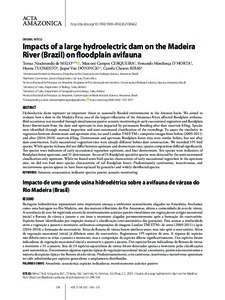Impacts of a large hydroelectric dam on the Madeira River (Brazil) on floodplain avifauna
Melo Tomaz Nascimendo de; Cerqueira Marconi Campos; d’Horta Fernando Mendonça; Tuomisto Hanna; Van doninck Jasper; Ribas Camila Cherem
https://urn.fi/URN:NBN:fi-fe2022020818026
Tiivistelmä
Hydroelectric dams represent an important threat to seasonally flooded environments in the Amazon basin. We aimed to evaluate how a dam in the Madeira River, one of the largest tributaries of the Amazonas River, affected floodplain avifauna. Bird occurrence was recorded through simultaneous passive acoustic monitoring in early successional vegetation and floodplain forest downstream from the dam and upstream in sites impacted by permanent flooding after dam reservoir filling. Species were identified through manual inspection and semi-automated classification of the recordings. To assess the similarity in vegetation between downstream and upstream sites, we used Landsat TM/ETM+ composite images from before (2009-2011) and after (2016-2018) reservoir filling. Downstream and upstream floodplain forest sites were similar before, but not after dam construction. Early successional vegetation sites were already different before dam construction. We recorded 195 bird species. While species richness did not differ between upstream and downstream sites, species composition differed significantly. Ten species were indicators of early successional vegetation upstream, and four downstream. Ten species were indicators of floodplain forest upstream, and 31 downstream. Seven of 24 floodplain specialist species were detected by the semi-automated classification only upstream. While we found some bird species characteristic of early successional vegetation in the upstream sites, we did not find most species characteristic of tall floodplain forest. Predominantly carnivorous, insectivorous, and nectarivorous species appear to have been replaced by generalist and widely distributed species.
Kokoelmat
- Rinnakkaistallenteet [27094]
